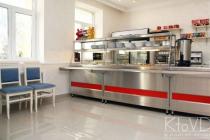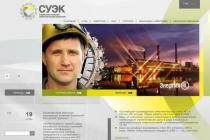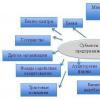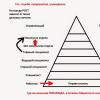→
Stages and composition of design
Project documentation is developed at the following stages:
1. Stage "Draft Design" (pre-project proposal)
2. Stage "Project documentation"
3. Stage "Working documentation"
4. Stage "Working draft"
Stage "Draft Design" (pre-project proposal)
is a design and construction stage that is not subject to approval by the state supervision authorities. The preliminary design contributes to a more detailed study of all the parameters of the object before making final decisions on all sections, which include the design of buildings and structures.
"Draft design" is carried out with the aim of:
Urban planning justification for the placement of a new construction object,
Demonstration of the appearance and internal layouts of the designed object
Determining the investment attractiveness of the project,
Possibilities of construction or reconstruction of an object on a given site, taking into account urban planning, historical, cultural, socio-economic, sanitary, hygienic and environmental requirements.
The composition of the draft design:
1. Explanatory note
2. Situational plan with adjacent territories
3. General plan (scheme of land organization)
4. Floor plans with explications of the premises
5. Sections with a description of "pies" and structural elements
7. Color and volume solutions of facades
8. Photomontage of the object in the existing situation
9. 3D Visualization
Design documentation at the stage "Draft design" is developed in the amount necessary to obtain the initial permit documentation.
Stage "Project documentation"
approved stage of design of construction and reconstruction facilities. Developed in accordance with government regulations, rules and standards.
At present, the composition of sections of project documentation is indicated in many regulations and in particular by Decree of the Government of the Russian Federation No. 87 dated February 16, 2008. "On the composition of sections of project documentation and requirements for their content."
The composition of the project documentation includes:
Explanatory note
Scheme of the planning organization of the land plot
Architectural solutions
Structural and space-planning solutions
Power supply system
Water supply system
Drainage system
Ventilation and air conditioning system
Heating system
Communication networks (television, telephone and radio installation, computer network)
Technological solutions
Construction organization project
Project for the organization of work on the demolition or dismantling of capital construction projects
Measures for environmental protection
Fire safety measures
Accessibility measures for persons with disabilities
Measures to ensure compliance with the requirements of energy efficiency and the requirements for equipping buildings, structures and structures with metering devices for the energy resources used
The project of automatic fire alarm and warning people about the fire.
Additional sections:
CCTV
access control and management
automation (dispatching) of engineering systems
security alarm
fire extinguishing system
vertical transport (elevator)
Project of on-site engineering networks
Project of off-site engineering networks
Design documentation at the stage "Project" is the basis for the development of "Detailed documentation".
Project documentation at the "Project" stage is required for approval by state supervisory authorities.
Stage "Working documentation"
The stage of working documentation includes
the previous stage - design documentation" and a set of documents required for construction and installation works. The composition of the working documentation for new construction or reconstruction of buildings and structures is determined by the relevant state standards and is specified by the customer and the designer in the design contract.
In two stages (design and working documentation), projects are developed when particularly complex objects are designed with new design solutions, complex architectural and construction solutions.
The working documentation of buildings and structures in case of two-stage design is developed after the approval of the documentation at the stage "Project documentation" in accordance with the decisions made therein.
Project documentation in case of affecting the load-bearing structures of the building is MANDATORY subject to state expertise.
It should also be noted that the design organization that developed the design documentation is fully responsible for the proposed design solutions, so engineers have the right to request from the customer the necessary data and documentation for the design or convince them to conduct an additional technical survey.
The stage "Working project" includes:
One-stage design (working design) makes it possible to reduce the project development time by 1.5-2 times and reduce the cost of design by 30%. As part of the Working Design, in some cases, if necessary, for objects of medium complexity, it is allowed to develop design solutions in the scope of the Design, and then finalize working drawings based on them.
The composition of the design documentation can be reduced or increased, depending on the Terms of Reference for the design.
In many cases, customers do not pay much attention to the Working Documentation, trying to do everything in parallel (construction and working documentation), which leads to delays in the work and additional financial costs. We advise you to follow the order. Doing everything gradually, but qualitatively. When a complete set of working documentation is ready, you can start construction without fear.
It is also possible to carry out the development of project documentation at the stage of "Detailed Design" with the allocation of the approved part for the necessary approvals in the state supervisory authorities.
The necessary documents for the development of your individual project will be determined by our specialists, based on the documents that you have in your hands.
It should be said that any project documentation is subject to approval by state supervisory authorities.
The design of buildings can only be entrusted to highly qualified specialists, true professionals in their field, who will quickly and efficiently perform the assigned work.
Reference
In accordance with accepted standards, design is carried out in one or two stages.
essence two-stage design consists in the fact that the documentation necessary for construction is not compiled immediately, but in stages:
At the first stage ( stage "P" - Project) decisions of a fundamental nature are made without detailing regarding the choice of the type of structure, its location, the main architectural, planning and design decisions, the method of construction, the principal schemes of technological processes, decisions on engineering equipment are selected. Consolidated estimates are being carried out, issues of organizing construction are being resolved. All this documentation is sent to the state expertise, which gives its comments and overall assessment of the project. After the designer eliminates the identified deficiencies, the project is considered and approved (or rejected) by the Customer (Investor).
At the second stage ( stage "RP" - Working Draft) working documentation is being developed ( "RD"). At this stage, the decisions made at the "P" stage are clarified and detailed, working drawings, local estimates and other documentation necessary for the production of construction and installation works are drawn up. "Working documentation" - these are the drawings and textual material that is used directly at the construction site (documentation of the "P" stage, as a rule, is not transferred to the builders).
The advantage of such a system is to minimize the cost of reworking design documentation in case of unsuccessful overall solutions. This is the main design method.
At one-stage design project documentation is prepared immediately in full and contains solutions to all general and particular issues. This is useful for low-volume design work for simple objects, or for linking bulk or reusable projects.
The composition of the project documentation and its requirements are clearly defined by the regulation. After development, project documentation must be submitted for state examination in accordance with Decree of the Government of the Russian Federation of March 5, 2007 N 145 ("On the procedure for organizing and conducting state examination of project documentation and engineering survey results").
working documentation is developed in order to implement architectural, technical and technological solutions in the construction process.
The regulation does not contain instructions on the sequence of development of working documentation, which determines the possibility of its implementation, both simultaneously with the preparation of project documentation, and after its preparation. At the same time, the volume the composition and content of the working documentation should be determined by the customer (developer) depending on the degree of detail of the solutions contained in the design documentation, and indicated in the design assignment. (see Letter of June 22, 2009 N 19088-SK / 08 of the Ministry of Regional Development of Russia)
The final set of design and estimate documentation, as a rule, includes design and working documentation ( Note. This is one of the main differences from the "P" and "RP" design stages, when only the documentation of the "RP" stage goes into the final project.). These types of documentation complement each other:
· The project documentation includes the main sections on the organization of construction("Explanatory note", "Construction organization project", "Measures to ensure fire safety", "Estimate for the construction of capital construction facilities", etc.).
· Working documentation contains working drawings, documents, specifications and is the basis for the implementation of the decisions taken in the project.
Project documentation
Reference
The list of design documentation is usually given in the section "Composition of design documentation" (section code - "SP"). This section is most often found in Volume 0.
The regulation establishes that design documentation for capital construction facilities for industrial and non-industrial purposes should include 12 sections:
Section 2 "Scheme of the planning organization of the land"
Section 3 "Architectural solutions"
Section 4 "Constructive and space-planning solutions
Section 5 "Information on engineering equipment, on networks of engineering and technical support, a list of engineering and technical measures, the content of technological solutions"
subsection "Power supply system";
subsection "Water supply system";
subsection "Water disposal system";
subsection "Heating, ventilation and air conditioning, heating networks";
subsection "Communication networks";
subsection "Gas supply system";
Subsection "Technological solutions".
Section 6 "Construction organization project"
Section 7 "Project for the organization of work on the demolition or dismantling of capital construction projects"
Section 8 "List of measures for environmental protection"
Section 9 "Fire safety measures"
Section 10 "Measures to ensure access for persons with disabilities"
Section 10(1) "Measures to ensure compliance with energy efficiency requirements and requirements for equipping buildings, structures and structures with metering devices for energy resources used"
Section 11 "Estimates for the construction of capital construction projects"
Section 12 "Other documentation in cases provided for by federal laws"
Design documentation for linear capital construction facilities and requirements for the content of these sections consists of 10 sections:
Section 1 "Explanatory note"
Section 2 "Project of the right of way"
Section 3 "Technological and design solutions for a linear facility. Artificial structures"
Section 4 "Buildings, structures and structures included in the infrastructure of a linear facility
Section 5 "Construction organization project
Section 6 "Project for the organization of work on the demolition (dismantling) of a linear facility
Section 7 "Measures for environmental protection"
Section 8 "Measures to ensure fire safety
Section 9 "Estimate for construction"
Section 10 "Other documentation in cases provided for by federal laws"
The composition of the design documentation for the overhaul objects is determined on the basis of the task of the developer or technical customer, depending on the content of the work performed. (see Urban Planning Code, Article 48, Clause 12.1)
If necessary, at the initiative of the customer, project documentation is developed in relation to individual stages of construction, reconstruction of facilities. (see Urban Planning Code, Article 48, Clause 12.2). This is indicated in the design assignment.
Design documentation for individual stages of construction is developed in the volumes necessary for the implementation of each stage of construction. It must meet the requirements for the composition and content of sections of project documentation established by the Regulations for capital construction projects.
Reference:
Under construction phase means the construction of one of the capital construction objects, the construction of which is planned to be carried out on one land plot, if such an object can be put into operation and operated autonomously, that is, regardless of the construction of other capital construction objects on this land plot, as well as the construction of a part of the capital construction object , which can be put into operation and operated autonomously, that is, regardless of the construction of other parts of this capital construction facility.
working documentation
Reference
The list of working documentation is usually drawn up as a "Summary sheet of the main sets of working drawings" (code - "CB"). A list of working drawings can either be drawn up as a separate document or be an annex to the section “Composition of design documentation.
The composition and content of the working documentation is determined by the Customer at the stage of preparing a design assignment, based on the characteristics of the capital construction object.
Requirements for the composition and content of sections of project documentation in the course of construction, reconstruction and overhaul of capital construction projects are determined by law.The main document governing this is
« Composition and requirements for the content of sections of project documentation in relation to various types of capital construction objects, including linear objects, the composition and requirements for the content of sections of project documentation in relation to individual stages of construction, reconstruction of capital construction objects, the composition and requirements for the content of sections of project documentation during the overhaul of capital construction objects, as well as the composition and requirements for the content of sections of project documentation submitted for state examination of project documentation and to state construction supervision bodies are established by the Government of the Russian Federation.()
working documentation is developed in order to implement architectural, technical and technological solutions in the construction process.
The regulation does not contain instructions on the sequence of development of working documentation, which determines the possibility of its implementation, both simultaneously with the preparation of project documentation, and after its preparation. At the same time, the volume the composition and content of the working documentation should be determined by the customer (developer) depending on the degree of detail of the solutions contained in the design documentation, and indicated in the design assignment. (see Letter dated June 22, 2009 N 19088-SK / 08 Ministry of Regional Development of Russia)
The final set of design and estimate documentation, as a rule, includes design and working documentation ( Note. This is one of the main differences from the "P" and "RP" design stages, when only the documentation of the "RP" stage goes into the final project.). These types of documentation complement each other:
- The project documentation includes the main sections on the organization of construction("Explanatory note", "Construction organization project", "Measures to ensure fire safety", "Estimate for the construction of capital construction facilities", etc.).
- Working documentation contains working drawings, documents, specifications and is the basis for the implementation of the decisions taken in the project.
Project documentation
Reference
The list of design documentation is usually given in the section "Composition of design documentation" (section code - "SP"). This section is most often found in Volume 0.
If necessary, at the initiative of the customer, project documentation is developed in relation to individual stages of construction, reconstruction of facilities. (cm. ). This is indicated in the design assignment.
Design documentation for individual stages of construction is developed in the volumes necessary for the implementation of each stage of construction. It must meet the requirements for the composition and content of sections of project documentation established by the Regulations for capital construction projects.
Reference:
Under construction phase means the construction of one of the capital construction objects, the construction of which is planned to be carried out on one land plot, if such an object can be put into operation and operated autonomously, that is, regardless of the construction of other capital construction objects on this land plot, as well as the construction of a part of the capital construction object , which can be put into operation and operated autonomously, that is, regardless of the construction of other parts of this capital construction facility.
When it becomes necessary to develop a project, the customer and the design organization need to understand what stage of design is necessary for a particular object. For some objects it is possible to perform design work in one stage, for others - in two stages, for especially complex objects it is necessary to perform three stages of design. So for example, it is performed in one stage, in two stages, or a large supermarket is performed in three stages. The price for the development of each stage is different and is determined on the basis of the state collections of prices for design work for construction (SCPRS).
In this article, we will consider the main stages of design, as well as the terms and definitions used in the development of project documentation.
According to DBN A.2.2-3:2012, there are the following design stages:
— feasibility study ( feasibility study
);
— technical and economic calculation ( FER
);
- preliminary design ( EP
);
- project ( P
);
- working draft RP
);
— working documentation ( R
)
Let's take a closer look at each of them.
Feasibility study stage (TER)
. It is developed on the basis of the customer's assignment for industrial facilities and linear engineering and transport infrastructure facilities that need a detailed justification of the relevant decisions and the determination of options and the feasibility of building the facility.
FER is used for technically simple production facilities and linear engineering and transport infrastructure facilities. The feasibility study is carried out in a reduced volume compared to the feasibility study, in accordance with the nature of the object and the requirements of the task.
EP stage
. It is developed on the basis of the customer's assignment for the fundamental determination of the requirements for urban planning, architectural, artistic, environmental and functional solutions of the object, confirmation of the possibility of creating a non-industrial object.
As part of the EP, in order to substantiate the decisions made on the instructions of the customer, calculations of the main design decisions, estimated cost and justification of the effectiveness of investments are carried out, and engineering and technical developments, schemes for engineering support of the facility can also be additionally performed.
Stage P.
It is developed to determine the urban planning, architectural, artistic, environmental, technical, technological, engineering solutions of the object, the estimated cost of construction.
P is developed on the basis of the design assignment, initial data and the previous stage approved during the three-stage design. Sections of stage P are given in a clear and concise form, without excessive detail, in the composition and volume sufficient to justify design decisions, determine the volume of basic construction work, the need for equipment, building materials and structures, provisions for organizing construction, as well as determining estimated construction cost.
RP stage.
It is developed for technically simple objects, as well as objects using projects (design solutions) of reuse.
The RP is developed to determine the urban planning, architectural, artistic, environmental, technical, technological, engineering solutions of the facility, the estimated cost of construction and construction work. WP is an integrating design stage and consists of two parts - approved and working documentation.
Stage R. Developed on the basis of the approved previous stage. After the approval of stage P, according to the decision of the customer, the working documentation can be developed by the author of the project or another designer. The development of working documentation by other designers is carried out in compliance with the author's decisions of the approved P and copyright.
Design stages depending on the complexity of the object:
1. For objects I and II categories of complexity
design is carried out:
a) In one stage - a working draft (WP);
b) In two stages - for non-production facilities - a draft design (EP), and for production facilities and linear objects of engineering and transport infrastructure - a feasibility study (FER) and for both - a working design (RP).
2. For objects III category of difficulty
design is carried out in two stages:
- project (P);
- working documentation (P).
3. For objects IV and V categories of complexity
design is carried out in three stages:
- for non-production facilities - EP or with appropriate justification of the feasibility study, and for production facilities and linear objects of engineering and transport infrastructure - a feasibility study (feasibility study);
- project (P);
- working documentation (P).
To the entry 5 comments
Anton, this article shows the design stages according to Ukrainian normative documents, namely DBN A.2.2-3:2012 "WAREHOUSE THAT ZMIST PROJECT DOCUMENTATION FOR BUDIVNITSTVO". IN Ukraine design stage " feasibility study«, « FER«, « EP«, « P«, « RP«, « R' are valid. When it comes to design stages for RF we have the following: |
|
Let's consider all stages of the project in order:
- Stage 2 - PD. Project documentation
Stage 1 - PP. Pre-project studies (Draft design)
At this stage, the concept of the future object is being developed, the main technical and economic characteristics are being determined. The sketch determines the landing of the object on the ground, its volumetric-spatial solution, and the structural scheme. Also at this stage, the main engineering loads for water, heat and electricity, the so-called. load calculation.
Development Stage "PP" is not mandatory, but helps to save time and money in further design.
Stage 2 - PD. Project documentation
Unlike the draft Stage "Project"(“PD” or simply “P”) is mandatory and subject to approval by state executive authorities. Based on the results of the approval of the Stage "Project", a permit for the construction of the facility is issued. The composition and content of this stage is regulated by Decree of the Government of the Russian Federation No. 87 of February 16, 2008. Of course, the composition will be individual for each project, but we will try to compile the most complete list of all possible sections and subsections of the “PD” Stage:
| Number | Partition code | Section name |
| Section 1 | Explanatory note | |
| Volume 1 | - OPP | Explanatory note |
| Volume 2 | - IRD | Initial permit documentation |
| Section 2 | - ROM | Scheme of the planning organization of the land plot |
| Section 3 | - AR | Architectural solutions |
| Section 4 | Structural and space-planning solutions | |
| Volume 1 | - KR1 | Reinforced concrete structures |
| Volume 2 | - KR2 | Metal constructions |
| Volume 3 | - KR3 | Wooden structures |
| Volume 4 | - KRR | Static calculation |
| Section 5 | Information about engineering equipment, about networks of engineering and technical support, a list of engineering and technical measures, the content of technological solutions. | |
| Subsection 1 | Power supply system | |
| Volume 1 | - IOS1.1 | Outdoor power supply |
| Volume 2 | - IOS1.2 | Power equipment |
| Volume 3 | - IOS1.3 | electric lighting |
| Subsection 2 | Water supply system | |
| Volume 1 | - IOS2.1 | Outdoor water supply |
| Volume 2 | - IOS2.2 | domestic water supply |
| Subsection 3 | Drainage system | |
| Volume 1 | - IOS3.1 | External drainage |
| Volume 2 | - IOS3.2 | Internal drainage |
| Subsection 4 | Heating, ventilation and air conditioning, heating networks | |
| Volume 1 | - IOS4.1 | Heating and ventilation |
| Volume 2 | - IOS4.2 | Heat supply |
| Volume 3 | - IOS4.3 | Individual heating point |
| Subsection 5 | Communication networks | |
| Volume 1 | - IOS5.1 | |
| Volume 2 | - IOS5.2 | |
| Volume 3 | - IOS5.3 | |
| Volume 4 | - IOS5.4 | CCTV |
| Volume 5 | - IOS5.5 | Security alarm |
| Volume 6 | - IOS5.6 | |
| Volume 7 | - IOS5.7 | Other low current systems |
| Subsection 6 | Gas supply system | |
| Volume 1 | - IOS6.1 | Outdoor gas supply |
| Volume 2 | - IOS6.2 | Internal gas supply |
| Subsection 7 | Technological solutions | |
| Volume 1 | - IOS7.1 | Technological solutions |
| Volume 2 | - IOS7.2 | |
| Volume 3 | - IOS7.3 | Air supply |
| Volume 4 | - IOS7.4 | Refrigeration |
| Volume 5 | - IOS7.5 | Steam supply |
| Volume 6 | - IOS7.6 | dust removal |
| Volume 7 | - IOS7.7 | Other technological systems |
| Section 6 | - PIC | Construction organization project |
| Section 7 | - UNDER | Project for the organization of work on the demolition or dismantling of capital construction projects |
| Section 8 | ||
| Volume 1 | - OOS | List of environmental protection measures |
| Volume 2 | - OOS.TR | Draft technological regulations for handling construction waste at the facility |
| Volume 3 | - IEI | Engineering and environmental surveys |
| Section 9 | ||
| Volume 1 | - PB1 | Fire safety measures |
| Volume 2 | - PB2 | |
| Volume 3 | - PB3 | |
| Volume 4 | - PB4 | |
| Section 10 | - ODI | Accessibility measures for persons with disabilities |
| Section 10(1) | - ME | Measures to ensure compliance with energy efficiency requirements and equipment requirements for buildings, structures and structures metering devices used energy resources |
| Section 11 | ||
| Volume 1 | - CM1 | Estimate for the construction of capital construction facilities |
| Volume 2 | - CM2 | Material price monitoring |
| Section 12 | Other documentation in cases stipulated by federal laws | |
| Volume 1 | - KEO | Lighting calculations of insolation and daylight (KEO) |
| Volume 2 | - ZSH | Noise and vibration protection measures. Noise impact assessment for the period of operation of the facility |
| Volume 3 | - ITM GOiChS | Engineering and technical measures of civil defense. Measures to prevent emergency situations |
| Volume 4 | - ED | Building instruction manual |
| Volume 5 | - PTA | Measures to counter terrorist acts |
| Volume 6 | - DPB | Declaration of industrial safety of hazardous production facilities |
Stage 3 - RD. working documentation
Stage "RD" first of all, builders need it, since it develops design solutions in the most complete and detailed way, which were only indicated in the “PD” Stage. Unlike "P", "Working" includes drawings of nodes, axonometric diagrams and profiles of engineering networks, specifications, etc. On the other hand, at the working stage, the documentation loses some sections, the completeness of which was exhausted at the design stage (for example , POS, OOS, KEO, ITM GOiChS, etc.). As in Stage "P", the composition of the "RD" will be individual for each project, but we will try to compile the most complete list of all possible sections of the Stage "Working documentation":
| Partition code | Section name |
| - GP | General plan |
| - TR | Transport facilities |
| - GT | General plan and transport (when GP and TR are combined) |
| - BP | Car roads |
| - pancreas | Railways |
| - AR | Architectural solutions |
| - AC | Architectural and construction solutions (when combining the Republic of Azerbaijan and the Kyrgyz Republic) |
| - AI | Interiors |
| - QOL | Constructive decisions. Reinforced concrete structures |
| - QOL0 | Constructive decisions. Reinforced concrete structures. Foundations |
| - KM | Constructive decisions. Metal constructions |
| - KMD | Constructive decisions. Detailing metal structures |
| - KD | Constructive decisions. Wooden structures |
| - KRR | Constructive decisions. Static calculation |
| - GR | Hydraulic Solutions |
| - ES | Power supply system. Outdoor power supply |
| - EM | Power supply system. Power equipment |
| - EO | Power supply system. electric lighting |
| - EN | Power supply system. Outdoor electric lighting |
| - EIS | Power supply of engineering systems |
| - HB | Water supply system. Outdoor networks |
| - NK | Water disposal system. Outdoor networks |
| - NVK | Water supply and sanitation system. Outdoor networks |
| - VC | Water supply and sanitation system. Internal networks |
| - HVAC | Heating, ventilation and air conditioning |
| - TS | Heat supply |
| - TM | Thermal mechanical solutions (boiler room, ITP, etc.) |
| - RT | Telephony, Radiofication, Telereception |
| - SCS | Structured cabling |
| - AIS | Automation of engineering systems |
| - ATP | Automation of technological processes |
| - AK | Integrated automation (when combining AIS and ATP) |
| - VN | CCTV |
| - OS | Security alarm |
| - ACS | Access control and accounting system |
| - GOS | Outdoor gas supply |
| - GSV | Internal gas supply |
| - TX | Technological solutions |
| - TK | Technological communications |
| - sun | Air supply |
| - XC | Refrigeration |
| - PS | Steam supply |
| - PU | dust removal |
| - AUPS - SOUE |
Automatic fire alarm installation, Warning and evacuation control system in case of fire |
| - APPZ | Fire protection automation |
| - Fri | Special fire extinguishing (water, powder, etc.) |
| - CD1 | Estimate for the construction of capital construction facilities |
| - CD2 | Material price monitoring |
| - AZ | Anti-corrosion protection |
| - TI | Thermal insulation of equipment and pipelines |
GOST R 21.1101-2013 Project documentation system:
4.2. working documentation
4.2.1. The composition of the working documentation transferred to the customer includes:
- working drawings intended for the production of construction and installation works;
- attached documents developed in addition to the working drawings of the main set.
4.2.2. The main sets of working drawings include general data on working drawings, drawings and diagrams provided for by the relevant standards of the Design Documentation System for Construction (hereinafter referred to as SPDS).
...
4.2.6. The attached documents include:
- working documentation for building products;
- sketch drawings of general views of non-standard products, performed in accordance with GOST 21.114;
- specification of equipment, products and materials, carried out in accordance with GOST 21.110;
- Questionnaires and dimensional drawings, performed in accordance with the data of equipment manufacturers;
- local estimate according to the forms;
- other documents stipulated by the relevant SPDS standards.
The specific composition of the attached documents and the need for their implementation are established by the relevant SPDS standards and the design assignment.
...
4.2.8. In working drawings, it is allowed to use standard building structures, products and assemblies by referring to documents containing working drawings of these structures and products. Reference documents include:
- drawings of typical structures, products and assemblies;
- standards, which include drawings intended for the manufacture of products.
Reference documents are not included in the working documentation transferred to the customer. The design organization, if necessary, transfers them to the customer under a separate agreement.
SNiP 11-01-95 Composition of working documentation:
5.1. The composition of the working documentation for the construction of enterprises, buildings and structures is determined by the relevant state standards of the SPDS and is specified by the customer and the designer in the design agreement (contract).
5.2. State, industry and republican standards, as well as drawings of typical structures, products and assemblies, to which there are references in the working drawings, are not part of the working documentation and can be transferred by the designer to the customer, if it is stipulated in the contract.














